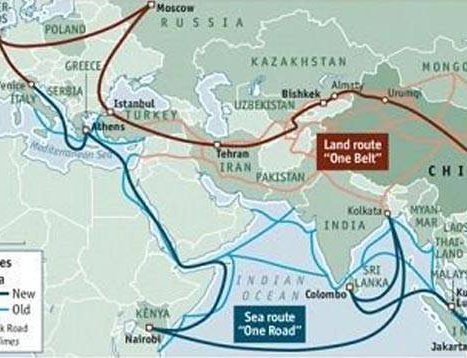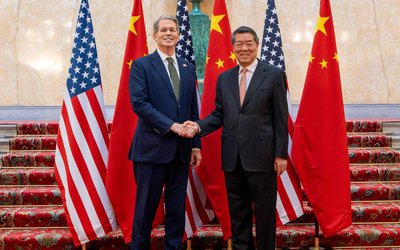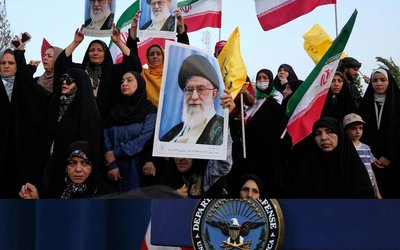
Prabhash K Dutta New Delhi, May
International observers may interpret India's decision to stay away from One Belt One Road summit as a step towards isolating itself from a global connectivity project.
India's concerns about the violation of territorial integrity and sovereignty were far more serious even though these might not have been the only region to boycott the Belt and Road Forum in Beijing. Nearly state heads from 30 countries attended the meet today.
Japan has also stayed away from the ambitious Chinese project aimed at reviving the ancient silk route - though the modern version is much more than the old one.
WHAT IS OBOR?
One Belt One Road is a bunch of transport projects building what could be seen as a ring road originating from the eastern part of China and ending on its coast.
It originates at Xi'an in northeastern China and passes through central Asia and west Asia to Rotterdam in the Netherlands via Moscow. This is purely a land route. The other half of the ring is largely maritime transport route passing through Venice, Athens in Italy and a host of African countries to end at Fuzhou on the eastern coast of China.
In the original plan, the maritime route would also pass through Colombo, Kolkata, Indonesia and Malaysia.
It is said to be a USD 1 trillion project. In the opening ceremony today in Beijing, Chinese President Xi Jinping promised USD 124 for the One Belt One Road without giving a time frame. The One Belt, One Road project involves 68 countries.
The China-Pakistan Economic Corridor is being flaunted as the flagship project of OBOR.
WHY CHINA IS BUILDING OBOR
Various reports suggest that Chinese economy is heading towards implosion under the changed economic realities of the world. China has overinvested in manufacturing sector over the past several years.
Chinese products are in surplus in many sectors particularly in steel, aluminum and cement. Its industries are suffering from overcapacity.
The Chinese economy is consistently slowing down for past few years. The global demand for Chinese products have shown decline in recent times. The domestic demands have also declined on account of weakening middle class.
China is facing a major crisis of job loss. A CNN report suggests that since beginning of 2016, about 12 lakh workers have been laid off in China. More job cuts are likely to happen in the country.
The project itself will give China the opportunity to send its workers throughout the world.
China is facing an impending economic crisis. This has been aggravated by recent emphasis by several governments to focus on domestic production. The Narendra Modi government announced its Make In India police in 2014.
Now, America First policy seems to be the guiding principle of Donald Trump administration in the US.
France, Brazil and many other countries are emphasizing on strengthening local industries. The British exit from the European Union has further complicated the matters for China.
China needed a spurt to save its industries and find new markets for its surplus goods.
WHAT CHINA AIMS AT THROUGH OBOR
China is looking for a robust market for its industrial goods. The Silk Road Economic Belt and 21st Century Maritime Silk Road - unveiled in 2013 - will be built under One Belt One Road project covering areas inhabited by about 4.4 billion people.
This will bring the biggest market closer to Chinese industries. This will also give China geostrategic leverage over a wide stretch of the planet. If the project turns out to be successful, China will unseat the US as the biggest super-power of the world.
But, there are big challenges. Many countries included in the OBOR project have been prone to political instability and violence including terrorism.
In Pakistan - which is China's all-weather friend - more than 13,000 soldiers are guarding the China-Pakistan Economic Corridor as it passes through terror hot-bed of Pakistan-occupied Kashmir and restive tribal regions of Pakistan.
Many central Asian and African countries have high scale corruption and economic instability that threatens the very idea of the OBOR.
HOW SHOULD INDIA DO
India can take cue from Japan, which too has refused to join the project. Japan launched its own Belt and Road initiative as Partnership for Quality Infrastructure.
Japan's project covers Indian-Pacific Oceanic and Eurasian regions. Japan has already invested around USD 150 million on the project.
Indian can win over its neighbors including Nepal, Bangladesh, Myanmar and Sri Lanka, and excluding Pakistan with a regional Belt and Road project. It is easier for India to develop regional connectivity in South Asia.
India can also actively engage with Japan's Belt and Road initiative to drive more benefits.
And, the last but not the least, India must improve its domestic connectivity and provide conducive environment to its own industries so that Chinese challenge can be met.
HIGHLIGHTS
1. One Belt One Road is about USD 1 trillion project of China.
2. Jinping today promised USD 124 billion at Belt and Road Forum today.
3. India and Japan stayed away from the Chinese initiative.
Source: India Today
- MELAMCHI WATER SUPPLY: No Interruption During Monsoon
- Jun 25, 2025
- KOREAN RETURNEES: Successful Integration
- Jun 25, 2025
- UPPER TRISHULI-1: Engaging With Local
- Jun 25, 2025
- IME GROUP: Twenty Five Years Of Journey
- Jun 24, 2025
- NEPAL’S AIR POLLUTION: A Growing Health Concern
- Jun 24, 2025














